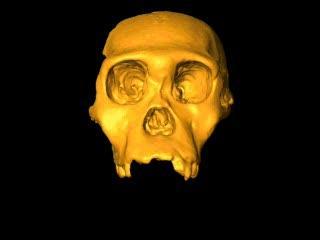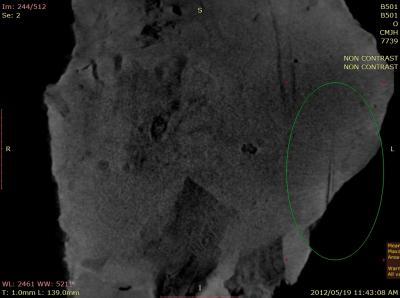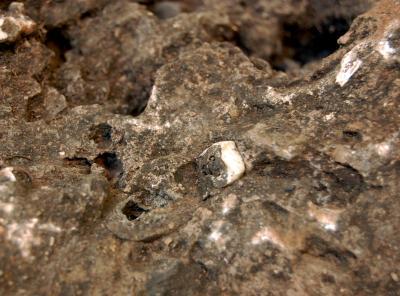New discovery
"We have discovered parts of a jaw and critical aspects of the body including what appear to be a complete femur (thigh bone), ribs, vertebrae and other important limb elements, some never before seen in such completeness in the human fossil record," says Berger. "This discovery will almost certainly make Karabo the most complete early human ancestor skeleton ever discovered. We are obviously quite excited as it appears that we now have some of the most critical and complete remains of the skeleton, albeit encased in solid rock. It's a big day for us as a team and for our field as a whole."
The remains are invisible to the casual observer and are entrenched in a large rock about one metre in diameter. It was discovered almost three years ago, but lay unnoticed in the Wits laboratories until early last month. Prof. Berger and his wife Jackie Smilg, a radiologist at the Charlotte Maxeke Hospital, who is conducting her PhD on the CT scanning of fossil material embedded in rock, scanned the large rock in a state of the art CT scanner.
A world first – Live Science!
In an unprecedented gesture of open access to science and public participation, the University of the Witwatersrand, the Gauteng Provincial Government and the South African national government announced that for the first time in history, the process of exploring and uncovering these fossil remains would be conducted live, captured on video, and conveyed to the world in real time. This will allow members of the public and the scientific community to share in the unfolding discovery in an unprecedented way.

This video shows a reconstructed skull -- revised parts put together with endocast and transparent cranium.
(Photo Credit: University of the Witwatersrand, Johannesburg)
A laboratory studio, designed in collaboration with the National Geographic Society, will be built at the Maropeng Visitor Centre in the heart of the Cradle of Humankind World Heritage Site. It will allow the public to view the preparation of this skeleton live if they visit Maropeng, or live on the internet. "The public will be able to participate fully in Live Science and future discoveries as they occur in real time – an unprecedented moment in palaeoanthropology," explains Berger. "The laboratory studio will be also linked to laboratories at Wits University and the Malapa site."
National Geographic
"We are excited to have helped make this cutting-edge facility possible for the University of the Witwatersrand," says National Geographic Executive Vice President Terry Garcia. "We can't wait to watch palaeontology happening in real time."
Virtual outposts
Access to the laboratory studio will not be limited only to visitors to the Cradle of Humankind and the internet. "We intend to create virtual 'outposts' in major partner museums around the world," says Berger. "These outposts will allow visitors to these partner museums the chance to interact with scientists in real time in a way we simply could not conceive of a few years ago. It is anticipated that the laboratory and virtual infrastructure will be built within a year, expanding our ambitious tourism and smart province infrastructure programme."
Berger adds that negotiations have begun with the Shanghai Science and Technology Museum, the Natural History Museum in the United Kingdom and the Smithsonian in Washington. "We have already donated casts of Australopithecus sediba to these three institutions, amongst others," says Berger. "It has also just been confirmed that one of the virtual outposts will be hosted in the new Shanghai Natural History Museum due to open later this year."

This is a probable hominin fibula (circled), in block 051. Note the shaft of a probable femur just above and to the left.
(Photo Credit: University of the Witwatersrand, Johannesburg)

This is the tooth of a hominid embedded in a rock containing significant parts of a skeleton of an early human ancestor. The skeleton is believed to be the remains of "Karabo", the type skeleton of Australopithecus sediba, discovered at the Malapa Site in the Cradle of Humankind in 2009.
(Photo Credit: University of the Witwatersrand, Johannesburg)
Source: University of the Witwatersrand